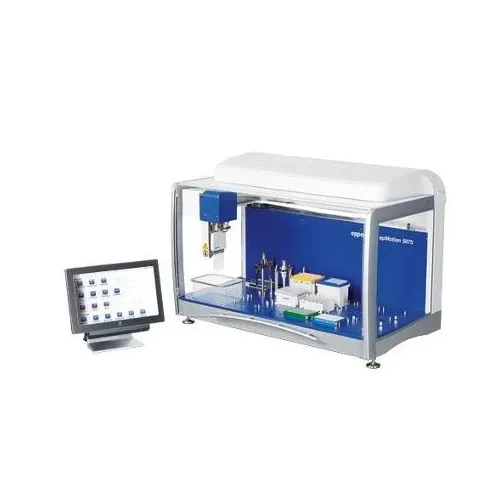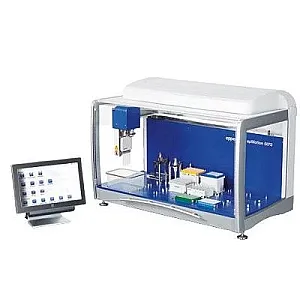The Eppendorf epMotion 5075 is an automated liquid handling system designed to deliver precision, flexibility and productivity in a wide range of laboratory applications. Capable of handling up to 15 work positions and automatically exchanging up to 4 tools, it is compatible with numerous optional modules, such as the ThermoMixer, thermal modules, an integrated vacuum system and a UV lamp for decontamination. Ideal for NGS library preparation, PCR/qPCR configurations, magnetic or filter-based purifications and cell assays, it significantly reduces manual handling time and improves the reproducibility of results.
epMotion 5075 Liquid Handling System - Good Condition 2020


Offer Details
Accessories :
42774
Options :
Delivery time between 4-6 weeks
Description
epMotion 5075 – High-performance automation for liquid handling
The Eppendorf epMotion 5075 is designed to meet the growing need for automation in research and analysis laboratories. With 15 SLAS/ANSI work positions, it offers plenty of space for integrating various types of consumables, adapters and specialised modules. The system ensures high pipetting accuracy over a range from 0.2 to 1,000 µL, with the option of switching automatically from one tool to another without manual intervention. The integration of options such as a gripper arm, one to three thermal modules, an Eppendorf ThermoMixer or a vacuum station allows complex protocols to be carried out without interruption, while maintaining consistent quality from start to finish.
Precision, reproducibility and ergonomics
The epMotion 5075 uses Eppendorf's air-cushion pipetting technology, combined with optical sensors that check the configuration of the work table, detect liquids and automatically identify tips. This combination guarantees reliable and reproducible results while minimising the risk of cross-contamination. The system is controlled by the MultiCon PC controller with intuitive epBlue software, based on a drag-and-drop principle, which makes it easy to create, modify and simulate methods. Integrated LED lighting and real-time status display make it easy to monitor operations, even from a distance. Ergonomics are enhanced by a closed, secure design that is suitable for use in controlled environments.
Versatility and wide range of applications
The flexibility of the epMotion 5075 allows it to be adapted to a wide range of applications, from preparing libraries for next-generation sequencing (NGS) to configuring PCR/qPCR reactions, magnetic bead or filter-based nucleic acid purification, immunoassays and cell assays. The CleanCap option, with UV lamp and air filtration system, ensures a clean working environment that meets the requirements of sensitive analyses. The wide range of compatible accessories and consumables further expands its capabilities, facilitating rapid adaptation to new protocols.
This system is therefore a strategic tool for improving productivity, reducing human error and standardising methods in modern laboratories.
Features
- Complete automation of pipetting tasks
- High precision and reproducibility
- Flexible management of complex protocols
- Compatible with a wide range of laboratory consumables
- Automatic tool exchange for step sequencing
- Simple programming without robotics expertise
- Visual monitoring of system status via LEDs
- Enhanced safety with closed enclosure and optional CleanCap
- Easy integration into regulated environments (21 CFR Part 11)
- Reduction of MSDs (musculoskeletal disorders) thanks to automation
Technical Details
- Up to 15 work positions in SLAS/ANSI format
- Volume range: 0.2 to 1,000 µL (depending on the tool used)
- Automatic exchange of 4 tools and gripper
- Compatible with microplates and PCR plates up to 384 wells
- Compatible with tubes from 0.2 mL to 50 mL
- Optical sensor for liquid detection, consumables and tips
- Liquid level detection without conductive tips
- Closed enclosure with safety mechanism on the door
- MultiCon PC controller with simulation, network and software updates
- epBlue software with drag-and-drop interface
- Optional modules: UV + air filter, up to 3 thermal modules, ThermoMixer, integrated vacuum station
- LED lighting for work surface illumination and status display
- Power supply: 100–240 V ±10%, 50–60 Hz ±5%
- Dimensions: 108.0 × 62.3 × 81.2 cm
- Weight: approx. 122 to 128 kg
Compatible Accessories
- Thermal modules (0–110 °C)
- Eppendorf ThermoMixer with 2DMix-Control technology
- Integrated vacuum station with silent pump
- CleanCap with UV lamp and air filtration
- Gripper arm for transporting consumables on the table
- Adapters and racks for tubes (0.2 to 50 mL) and microplates
- Reservoirs (10, 30, 100, 400 mL) and ReservoirRack modules
- TipHolder holders and epT.I.P.S. Motion tip refills
- Magnum FLX magnetic adapters for ball separation
- Racks for conical tubes, cryotubes and Safe-Lock
- Modules for specific PCR and NGS applications